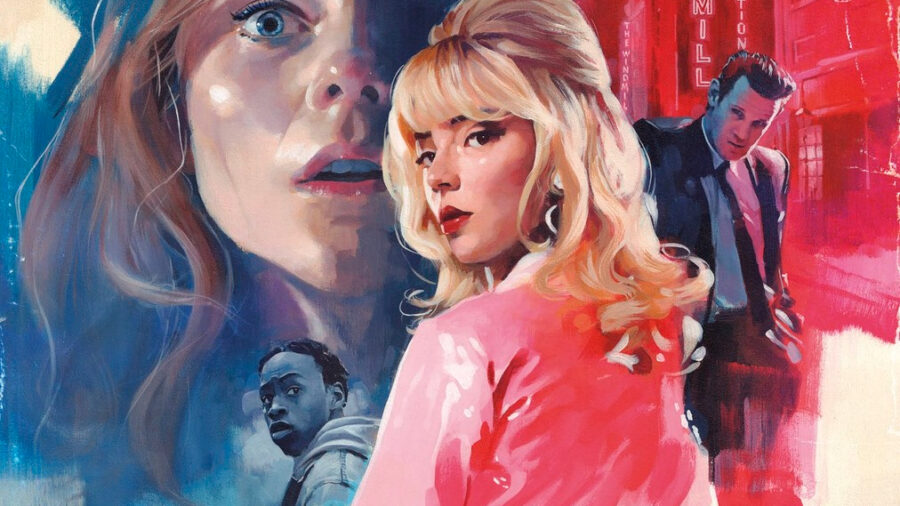Last Night in Soho Review: A Disturbing, Frenzied Horror Experience
Last Night in Soho goes full horror, but is it a successful attempt by writer/director Edgar Wright?
This article is more than 2 years old

Last Night in Soho is Edgar Wright’s first attempt at a full-blown horror movie. In comparison to writer/director Edgar Wright’s previous installation into the horror genre, the comedic but heartfelt Shaun of the Dead, his second go-around at an almost complex horror tale sees itself gradually shift from a stylish thriller that drips with dread to a full-blown horror that transforms stylish scares into a less-than-subtle fright fest. Britain in the 1960s has been previously satirized to death, yet Wright wants to pay homage to the glitz and glamor in his own disturbing, undeniably unsettling way.
In theory, the concept of Last Night in Soho is fascinatingly different and goes beyond what meets the eye: shimmering cocktails and glamorous lounges foreshadow the threat of insanity that drives London fashion student Eloise Turner (Thomasin McKenzie) from her state of wellbeing. Horror films usually take full advantage of the slow-burn method, whittling away at what makes its central protagonist tick, though there are half-answered questions that are left open by Wright. It’s not defined how the body-switching and decade-hopping take place outside of being experienced through Turner’s dreams. It cannot be described as time-travel, but it cannot be described as bodily possession either. Turner loses herself in her newfound alter-ego and undergoes an identity crisis that chips away at her mental health. The muddled middle ground of how ’60s showgirl Sandie’s (Anya Taylor-Joy) life becomes indistinguishable from Turner’s 21st-century reality remains blurred and unclear.
The reimagining of the swinging ’60s in London is bedazzled beyond belief, practically outshining the story that steps on its own toes. The streets of the city are transformed into a dazzling interpretation of the era by Wright, adorned with high-energy socialite clamoring and taking its time while wading through the liveliness of the time. The overwhelming of the senses finds its payoff, and Last Night in Soho‘s frequent revisitation of the ’60s always has something freshly mesmerizing to catch the eye. The soundtrack is comprised of classic tracks that were popular at the time. Wright elevates the use of music to ominously elevate the atmosphere and remain crucial to pushing the narrative forward. Last Night in Soho loses its footing when piecing together a concrete central story, but celebrates the cultural impact of the British Invasion.

Wright’s visually intoxicating, neon-drenched recreation of the time period glorifies the nightlife and the club atmosphere without burying away the truths behind rape culture and the treatment of women, especially aspiring stars who seek out their next big break. The gradual shift in attitude from Jack (Matt Smith) whose facade of a natural charmer fizzles out into tempered abuser illustrates the reality of the sexual and mental abuse that has gone unspoken. It elaborates on how the objectification of women became accepted, if not welcomed into practice, throughout the club culture. The film serves as a deeply chilling, fictionalized reflection on the reality of an incredibly taboo subject. There is a steady decline of Turner’s temporary euphoria after Sandie finds her voice and begins to use the power behind the word “no.” The turning point triggers the trouble that plunges deeper into Last Night in Soho and the shift into the subgenre of horror that Wright wants to run with.
The horror film wants to excuse itself from its horror cliches, but can’t find that defining streak of individuality outside of locking onto the aesthetics of the British Invasion. It watches itself transform from a psychological thriller into a slasher flick, and the grip of discomfort simmers out into an array of jump scares. The twists that are teased early on nearly betray themselves before Wright can time the surprise when he wants to see it strike. Last Night in Soho seeks out its strength from its hypnagogic-turned-nightmarish cinematics and being able to call attention to the actualities of how rape culture impacts a person far beyond the act of assault itself.
The most horrifying aspect of Last Night in Soho is not the supernatural nor paranormal elements that Wright interweaves into his work, where faceless ghosts unrelentingly haunt the film’s later acts. Instead, it is the psychological aftermath of rape trauma creeping into every moment of life. While the third act becomes overwhelming and frenzied before boiling down to a calm ending on an uplifting note, the greatest scare of all is the unshakable residual fear that lingers far past Wright’s feel-good final scene.













